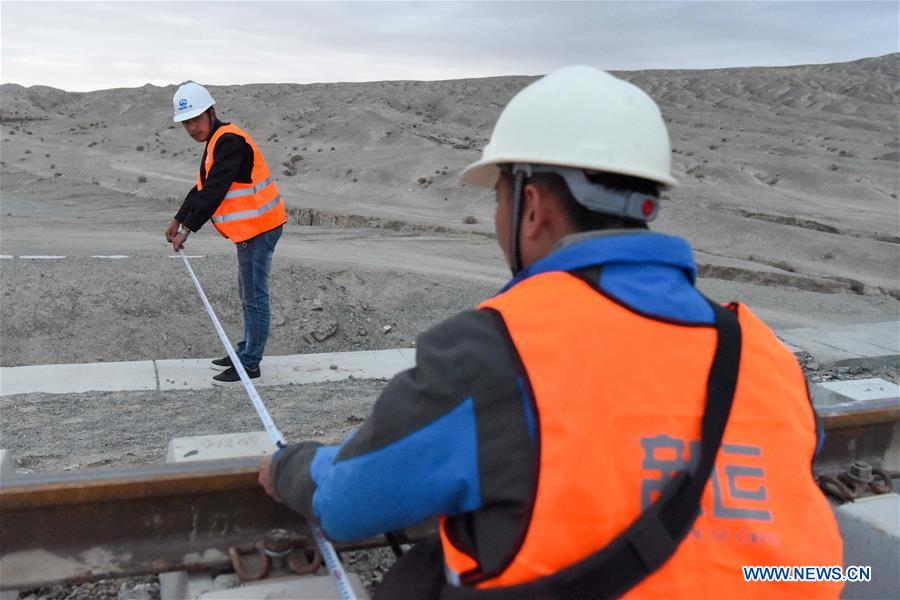
Sun Hui checks rails at the construction site of the railway linking the city of Golmud in Qinghai and the city of Korla in northwest China's Xinjiang Uygur Autonomous Region, July 19, 2020. (Xinhua/Ding Lei)
URUMQI, July 30 (Xinhua) -- While many of his peers are hanging out with friends and seeking white-collar jobs, 24-year-old Sun Hui is building his career, one railway sleeper at a time, in the desert at an altitude of some 3,000 meters in northwest China's Xinjiang Uygur Autonomous Region.
Tanned by the strong sun, Sun Hui barely looks his age. "You can call it a 'railway tan'," Sun said jokingly.
As a railway worker with China Railway First Group Co., Ltd., Sun is the youngest of a team currently building a railway linking the city of Golmud in Qinghai and the city of Korla in Xinjiang.
The 1,213.7-km Golmud-Korla Railway, which finished track-laying earlier this month, crosses a variety of landscapes including deserts, plateaus and mountains as well as natural reserves.
Sun graduated from a railway college in 2018 and joined the team with four classmates as a technician. Yet he never expected the construction of the railway to be so arduous.
"As soon as the wind picks up, there's nothing but sand on the menu. Don't eat and you'll starve, eat and you'll gag," Sun said.
The railway crosses vast stretches of no-man's-land, with no accommodation available. Sun and his co-workers have to live in makeshift dormitories that are set on rail tracks and move as they proceed with the project.
"It can be very cold in winter, and in summer, you have to battle with swarms of mosquitoes," said Sun.
The harsh working environment, however, hasn't daunted Sun, who grew up in a city in Ningxia Hui Autonomous Region. He turned down an office job in early 2019, citing his preference to work in the field to gain first-hand experience. "Hardship is a natural part of growth," said Sun.
Zhao Zhenming, a project manager with the Golmud-Korla Railway, said the young railway workers are growing up fast as they are willing to learn and ready to overcome difficulties and shoulder responsibilities.
Sun now not only works as a technician, but also helps with human resources work. The railroad switch work for the last stops of the railway was completed under his supervision.
The Golmud-Korla Railway is expected to be put into operation later this year, and Sun cannot wait to be one of the first passengers on the train. "I will proudly tell the person sitting next to me that I helped build this railway."

Hao Duo (2nd L) works with his colleagues at the construction site of the railway linking the city of Golmud in Qinghai and the city of Korla in northwest China's Xinjiang Uygur Autonomous Region, July 19, 2020. (Xinhua/Ding Lei)

Sun Hui checks wind speed at the construction site of the railway linking the city of Golmud in Qinghai and the city of Korla in northwest China's Xinjiang Uygur Autonomous Region, July 19, 2020. (Xinhua/Ding Lei)

Sun Hui (L) and Hao Duo work at the construction site of the railway linking the city of Golmud in Qinghai and the city of Korla in northwest China's Xinjiang Uygur Autonomous Region, July 19, 2020. (Xinhua/Ding Lei)

Aerial photo shows staff members working at the construction site of a section of the railway linking the city of Golmud in Qinghai and the city of Korla in northwest China's Xinjiang Uygur Autonomous Region, on July 18, 2020. (Xinhua/Ding Lei)

Sun Hui updates with colleagues through a walkie-talkie at the construction site of a section of the railway linking the city of Golmud in Qinghai and the city of Korla in northwest China's Xinjiang Uygur Autonomous Region, July 19, 2020. (Xinhua/Ding Lei)
